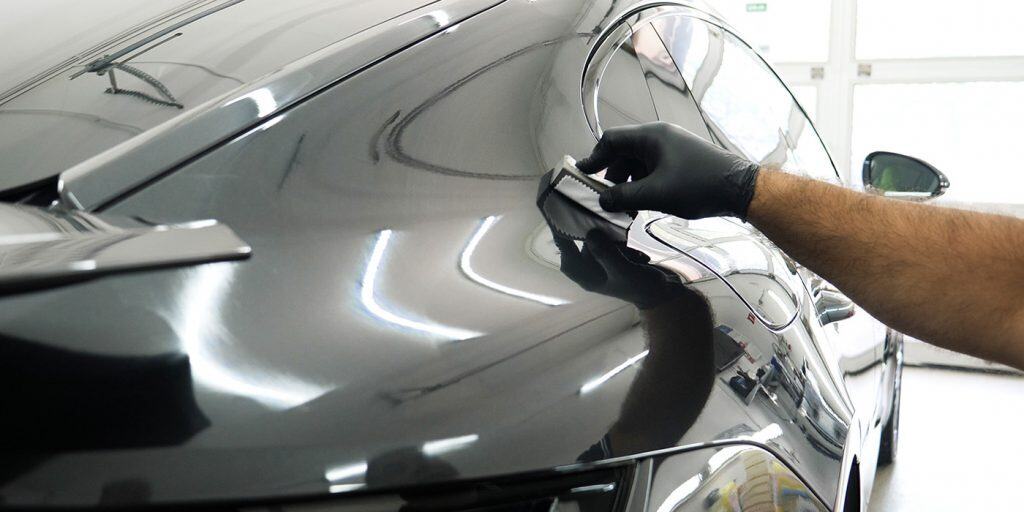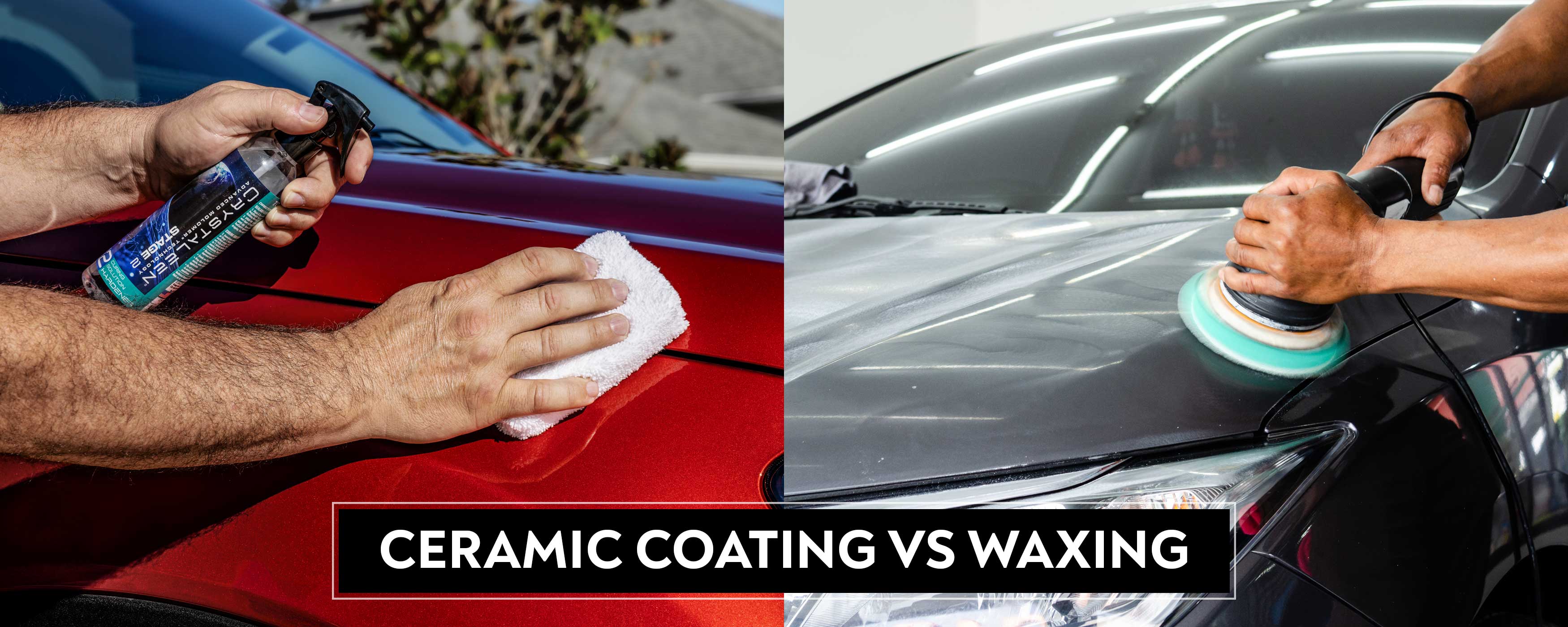Ceramic Coating: The Future of Automotive Surface Protection
Ceramic Coating: The Future of Automotive Surface Protection
Blog Article
Ceramic Covering vs. Standard Wax: Which Offers Much Better Long-Term Defense?
The debate between ceramic finishings and standard wax for car security has actually garnered substantial interest among auto lovers and experts alike. Ceramic finishings boast remarkable durability and resistance to ecological elements, yet the complexity of their application elevates concerns concerning accessibility and usefulness.
Review of Ceramic Finishing
Ceramic coating has gained substantial popularity amongst automobile fanatics and detailers alike due to its innovative safety high qualities. This innovative technology is developed to create a sturdy, hydrophobic shield over a lorry's paint surface, considerably boosting its resistance to environmental pollutants such as dust, UV rays, and chemical spots. Unlike traditional wax, which supplies a temporary layer of security, ceramic layers bond at a molecular level with the paint, supplying resilient longevity-- usually extending beyond 2 years with correct maintenance.
The application process includes careful preparation of the automobile's surface area, including cleansing and brightening to make sure optimum adhesion. When applied, the finish remedies to create a robust layer that not just adds depth and gloss to the paint but likewise simplifies upkeep. With its hydrophobic buildings, ceramic finishing permits water and dust to glide off even more easily, lowering the regularity of cleans and minimizing the threat of swirl marks.
Additionally, ceramic coatings are available in various solutions, permitting users to select products tailored to their specific requirements and choices. Generally, ceramic finishing represents a considerable improvement in paint protection modern technology, supplying exceptional efficiency compared to traditional options.
Introduction of Conventional Wax
Generally considered as a staple in auto care, wax works as a popular option for those seeking an uncomplicated technique to enhance and secure their car's paint - ceramic coating. Automotive wax normally consists of all-natural ingredients, such as carnauba, or synthetic compounds, created to produce a protective layer externally of the paint. This layer not just enhances the vehicle's gloss and beam but likewise provides a barrier versus ecological pollutants
The application of wax is normally straightforward, making it available for both experts and DIY enthusiasts. It can be used by hand or equipment, permitting adaptability in the describing procedure. Once used, wax requires a healing period, after which it solidifies to form a safety covering. Wax is additionally understood for its ability to push back water, advertising a beading effect that assists in the avoidance of water places and corrosion.
Nonetheless, while wax is effective for enhancing the visual allure of an automobile, it is very important to keep in mind that the protection it provides may require a lot more regular reapplication compared to alternative products, such as ceramic coatings. Overall, conventional wax stays a preferred option for those focusing on ease of usage and immediate aesthetic improvement.
Toughness and Longevity Comparison
While both ceramic finishings and typical wax deal protective advantages for automotive paint, their sturdiness and longevity differ significantly. Traditional wax, typically made from all-natural carnauba or synthetic polymers, typically provides a protective layer that lasts around 3 to 6 months. This reasonably brief life expectancy requires regular reapplication to preserve optimum defense.
On the other hand, ceramic layers are engineered from innovative nanotechnology, forming a covalent bond with the paint surface area. This causes a durable, hydrophobic layer that can withstand for two to five years, depending upon the item and environmental conditions. The remarkable sturdiness of ceramic finishings is connected to their chemical structure, which offers enhanced resistance to scratches, UV rays, and oxidation.

Defense Against Environmental Elements
Protecting a lorry's paint from environmental elements is essential for keeping its look and value gradually. Vehicles are continuously revealed to a selection of aspects, consisting of UV rays, bird droppings, tree sap, acid rainfall, and road crud, every one of which can jeopardize the honesty of the paintwork.
Ceramic coverings give a robust protection versus these environmental assailants. Unlike standard wax, which can break down quickly under UV exposure, ceramic layers form a durable, hydrophobic layer that withstands the harmful impacts of sunlight and toxic wastes. This advanced modern technology produces a chemical bond with the lorry's surface area, supplying premium defense that lasts for several years, even in extreme conditions.
In contrast, ceramic coatings maintain their protective top qualities much longer, dramatically decreasing the threat of paint damages and making sure that the vehicle maintains its aesthetic appeal. As an outcome, ceramic coverings are progressively acknowledged as the superior selection for lasting security against ecological aspects.
Application and Maintenance Distinctions
The approaches of application web and subsequent upkeep for ceramic coverings and typical wax vary significantly, influencing the general user experience and efficiency of each product. Ceramic coverings require an even more elaborate application procedure, normally involving surface prep work that includes washing, sanitizing, and brightening the car. Once the surface prepares, the ceramic covering is applied in a controlled setting, frequently requiring specialist experience to make sure correct healing and bonding to the paint.

While both products enhance automobile look, the longer-lasting defense offered by ceramic coverings might warrant their first financial investment, despite the more requiring application process. Conversely, conventional wax stays a popular YOURURL.com choice for those looking for a less complex, albeit temporary, service.

Verdict
Finally, ceramic finishes demonstrate considerable benefits over standard wax in terms of toughness and environmental management. With a lifespan extending 2 to 5 years and superior resistance to UV rays, dust, and chemical discolorations, ceramic coverings use a more effective service for long-lasting vehicle maintenance. The application procedure may require expert expertise, the resulting expense savings and decreased regularity of reapplication emphasize the value of ceramic finishings for those seeking ideal vehicle protection.
The discussion between ceramic coverings and typical wax for automobile protection has actually garnered considerable interest among automobile enthusiasts and specialists alike. Unlike traditional wax, which provides a short-lived layer of protection, ceramic finishes bond at a molecular degree with the paint, supplying durable toughness-- often expanding past two years with correct upkeep.
While both ceramic finishes and conventional wax deal protective advantages for auto paint, their sturdiness and longevity differ considerably. For car fanatics looking for long-term defense, ceramic layers provide a compelling benefit over traditional wax products.
In conclusion, ceramic coverings show considerable benefits over typical wax in terms of resilience and ecological security.
Report this page